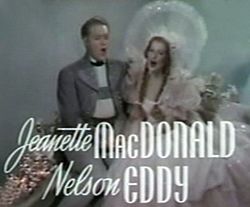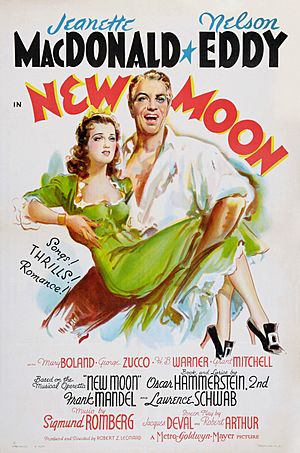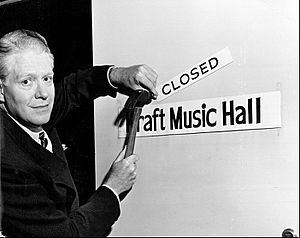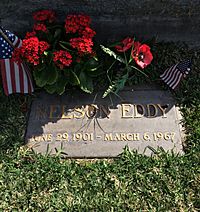Nelson Eddy facts for kids
Quick facts for kids
Nelson Eddy
|
|
|---|---|
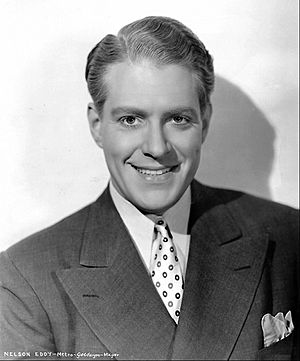
Eddy in 1935
|
|
| Born |
Nelson Ackerman Eddy
June 29, 1901 Providence, Rhode Island, U.S.
|
| Died | March 6, 1967 (aged 65) Miami Beach, Florida, U.S.
|
| Resting place | Hollywood Forever Cemetery |
| Occupation |
|
| Years active | 1922–1967 |
| Spouse(s) |
Ann Denitz Franklin
(m. 1939) |
| Children | 1 son Jon Eddy |
Nelson Ackerman Eddy (born June 29, 1901 – died March 6, 1967) was a famous American singer and actor. He starred in 19 musical movies in the 1930s and 1940s. He also sang in operas, on stage, on the radio, and on TV. Nelson was known for his deep, rich singing voice called a baritone.
He is best remembered for the eight movies he made with the singer Jeanette MacDonald. Nelson Eddy was one of the first "crossover" stars. This means he was popular with both young fans and serious opera lovers. At one point, he was the highest paid singer in the world!
During his 40-year career, Nelson Eddy earned three stars on the Hollywood Walk of Fame. These stars were for his work in movies, music recordings, and radio. He also left his handprints and footprints at Grauman's Chinese Theatre. He earned three gold records for his popular songs. In 1941, he was invited to sing at the third inauguration of U.S. President Franklin D. Roosevelt. He helped millions of young Americans discover classical music. He even inspired many of them to become musicians themselves.
Contents
Early Life and Musical Beginnings
Nelson Eddy was born in Providence, Rhode Island. He was the only child of Caroline and William Eddy. Nelson grew up in Providence, Pawtucket, Rhode Island, and New Bedford, Massachusetts. As a child, he had reddish-blond hair. People often called him "Bricktop." As he got older, his hair turned white early.
His family was very musical. His mother was a church soloist. His grandmother was a famous singer of oratorios (large musical works). His father sometimes worked backstage at the Providence Opera House. He also sang in the church choir and played drums.
Nelson's family was not rich. He had to leave school and moved with his mother to Philadelphia. His uncle helped him get a job at a plumbing company. Later, he worked as a reporter for several newspapers. He also worked briefly in advertising. But he was fired because he sang too much on the job! Nelson never went back to school. Instead, he taught himself through special courses.
Developing His Singing Voice
Nelson Eddy started singing as a boy soprano in church choirs. As a teenager, he studied voice. He practiced by imitating famous baritone singers. He gave small concerts for women's groups. He also performed in plays, often for free.
His first big break came in 1922. He performed in a play called The Marriage Tax. Even though his name wasn't in the program, the newspapers praised his singing. In 1924, Nelson won a competition. This gave him a chance to perform with the Philadelphia Opera Society. By the late 1920s, he was singing with the Philadelphia Civic Opera Company. He knew roles in 28 different operas.
Nelson also performed in Gilbert and Sullivan operas. He sang the main role of Strephon in Iolanthe in 1922. The next year, he played Major-General Stanley in The Pirates of Penzance.
He studied with several voice teachers. In 1927, he went to Dresden, Germany, to study more. This was common for serious American singers. He was offered a job with a German opera company. But he decided to return to America. He focused on his concert career instead. His first concert accompanist was Theodore (Ted) Paxson. Ted became a close friend and worked with Nelson for 39 years. Nelson was very interested in technology. He even had a home recording studio. He used it to study his own singing. This interest also led him to sing all three parts (tenor, baritone, and bass) for a singing whale character. This was for the Walt Disney animated movie Make Mine Music (1946).
Nelson Eddy continued to sing in operas sometimes. But his movie work made it hard to plan opera appearances. His last opera performances were in 1934. Critics praised his singing, saying he was one of America's best baritones. After he became famous in movies, he made sure to sing classical songs in his concerts. He believed audiences should hear all kinds of music.
Becoming a Hollywood Star
Hollywood "discovered" Nelson Eddy in 1933. He filled in at the last minute for a famous singer at a concert in Los Angeles. He was a huge success, getting 18 curtain calls! Many film offers followed right away. He decided that being in movies might help more people come to his concerts. His concert fee jumped from $500 to $10,000 per show!
Nelson signed with Metro-Goldwyn-Mayer (MGM) studio. He made 15 of his 19 movies there. His contract let him have three months off each year for his concert tours. At first, MGM wasn't sure how to use him. He spent over a year getting paid with little to do. He sang one song in a few early movies. Audiences liked him. So, he was cast as the main male lead. His co-star was the already famous Jeanette MacDonald. Their first movie together was Naughty Marietta (1935).
Naughty Marietta was a huge surprise hit in 1935. The song "Ah! Sweet Mystery of Life" became very popular. It earned Nelson his first gold record. The movie was nominated for an Oscar for Best Picture. Critics loved Nelson Eddy. They said he was a new movie star with a thrilling voice and good looks.
Nelson Eddy made seven more movies with Jeanette MacDonald:
- Rose Marie (1936) is one of his most famous movies. He sang "Song of the Mounties" and "Indian Love Call". His role as a Mountie became very popular. It was even copied in cartoons and TV shows.
- Maytime (1937) is considered one of his best films. The song "Will You Remember" earned him another gold record.
- The Girl of the Golden West (1938) had new songs by Sigmund Romberg.
- Sweethearts (1938) was MGM's first movie in Technicolor. It won an award for Best Picture of the Year.
- New Moon (1940) became one of his most popular films. He sang "Lover, Come Back to Me" and "Stout Hearted Men."
- Bitter Sweet (1940) was also in Technicolor. Nelson played a singing teacher who runs away with his student.
- I Married an Angel (1942) was based on a stage musical. Nelson sang "Spring Is Here".
Nelson Eddy also starred in movies with other leading ladies:
- Rosalie (1937), with Eleanor Powell. He played a football player and pilot who chases a princess.
- Let Freedom Ring (1939), a Western movie. Nelson fought bad guys to protect freedom.
- Balalaika (1939), with Ilona Massey. He played a prince in disguise during the Russian Revolution.
- The Chocolate Soldier (1941), with opera star Risë Stevens. Nelson played two roles and gave a great performance.
- Phantom of the Opera (1943) was his first movie after leaving MGM. It was a colorful musical.
- Knickerbocker Holiday (1944) was based on a popular musical.
- Make Mine Music (1946) was a Walt Disney animated movie. Nelson provided all the voices for the last part, "The Whale Who Wanted to Sing at the Met." He used his own recording skills to sing all the parts himself!
- Northwest Outpost (1947), with Ilona Massey. This was Nelson Eddy's last movie.
Music Recordings
Nelson Eddy made over 290 recordings between 1935 and 1964. He sang songs from his movies, opera songs, folk songs, and popular tunes. He recorded many duets with Jeanette MacDonald. Later, he recorded with other singers like Risë Stevens and Jo Stafford.
His recordings were very popular. Even in the 1960s, critics praised his voice. One newspaper wrote in 1964 that Nelson Eddy was "physically and vocally indestructible." They noted that his "romantic and robust baritone" voice had not changed much.
Radio and Television Appearances
Nelson Eddy started appearing on radio in the mid-1920s. He had his own radio shows, like The Electric Hour. He often used his shows to help young singers get started. He also made many guest appearances. He was a frequent guest on Lux Radio Theater, where he performed radio versions of his popular movies.
In the 1950s, he appeared on TV shows. He was a guest on Danny Thomas's sitcom Make Room for Daddy. He also appeared on variety shows like The Ford Show, Starring Tennessee Ernie Ford. He reunited with Jeanette MacDonald on TV shows like Lux Video Theater. He was also a frequent guest on talk shows. In 1955, he starred in a live TV version of the musical The Desert Song.
Nightclub Performances
As TV became more popular, concert tours changed. In the early 1950s, Nelson Eddy decided to start a nightclub act. It began in 1953 with singer Gale Sherwood and his accompanist, Ted Paxson. This act was very successful. Variety magazine wrote that Nelson Eddy won over the audience in less than a minute. His nightclub act continued for 15 years. They even toured Australia four times.
Personal Life
Nelson Eddy married Ann Denitz Franklin on January 19, 1939. Ann was the former wife of a famous director. Her son, Sidney Jr., became Nelson's stepson. Nelson and Ann did not have any children of their own. They were married for 27 years until Nelson's death. Ann Eddy passed away in 1987. She is buried next to Nelson and his mother. Nelson Eddy was a member of the Republican Party.
His Final Years
On March 5, 1967, Nelson Eddy was performing at a hotel in Miami Beach, Florida. He suddenly collapsed on stage. He had a brain hemorrhage. His singing partner, Gale Sherwood, and his accompanist, Ted Paxson, were with him. He died a few hours later on March 6, 1967, at Mount Sinai Medical Center. He was 65 years old.
Nelson Eddy is buried at Hollywood Forever Cemetery. His grave is between his mother and his wife.
His Legacy
Nelson Eddy's carefully noted music scores are now kept at Occidental College in Los Angeles. His personal papers and scrapbooks are at the University of Southern California Cinema/Television Library.
Discography
- Hymns We Love (1946, Columbia)
- Nelson Eddy in songs of Stephen Foster (1949 Columbia)
- Songs for Christmas (1951, Columbia)
- Nelson Eddy in Oklahoma! (1956, Columbia)
- The Desert Song (1956, Columbia)
- Nelson Eddy Favorites (1959, Columbia)
- A Starry Night (1960, Everest)
- Operetta Cameos (with Jeanette MacDonald) (1982, RCA Records Red Seal R263428 (e))
- The Artistry of Nelson Eddy (1994); CD 2009, Essential Media)
- Smilin' Through (2000, Memoir)
- As Years Go By (2013, Jasmine)
- Songs We Love (1950, Columbia Masterworks, A-965)
- A Perfect Day (Original 1935-1947 Recordings) (2002, Nostalgia Naxos, 8.120591)
Images for kids
See also
 In Spanish: Nelson Eddy para niños
In Spanish: Nelson Eddy para niños


